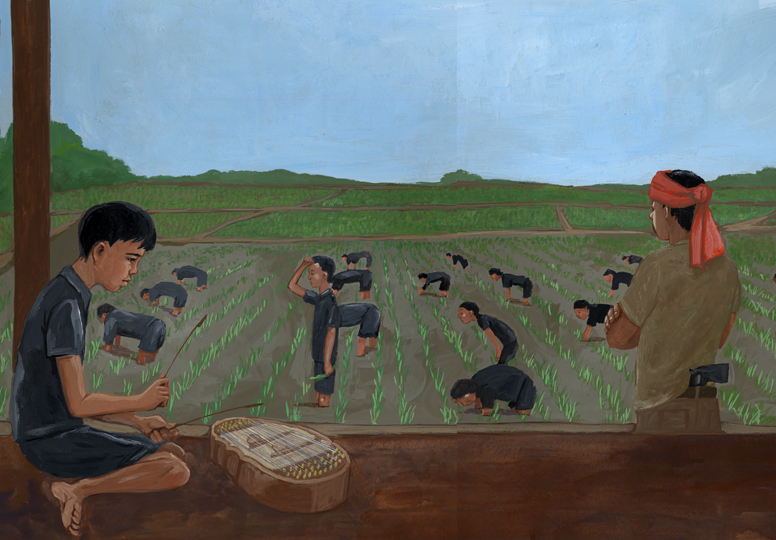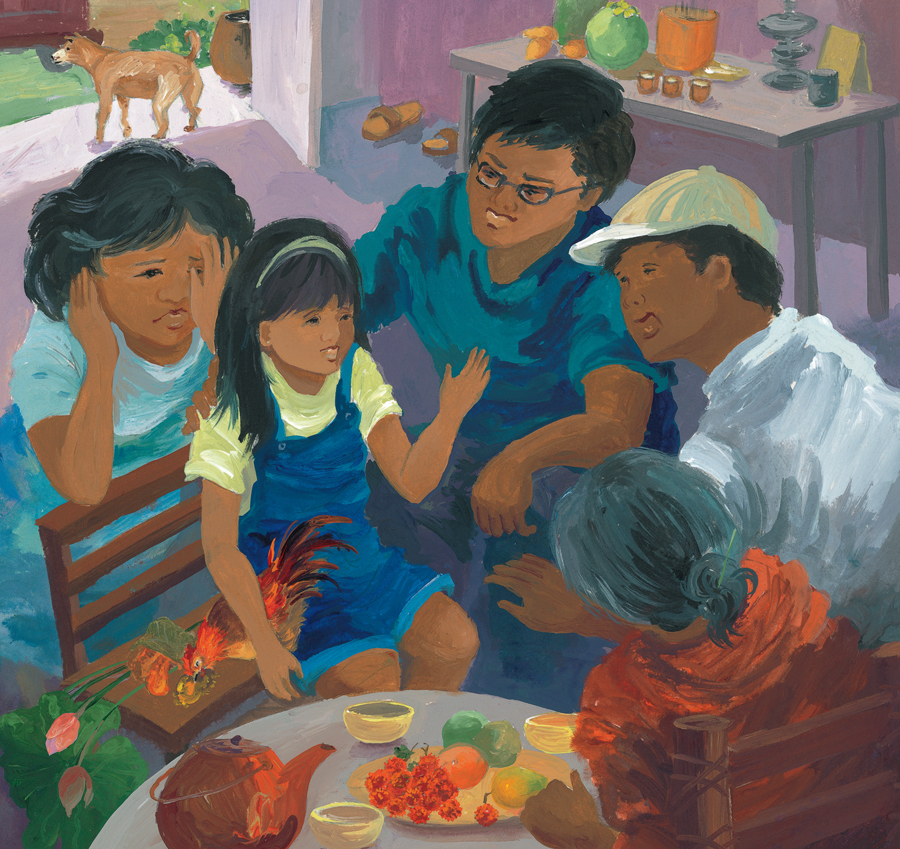
![]() Jane M. Gangi is Associate Professor in the Division of Education at Mount Saint Mary College in Newburgh, New York, where she is a member of the Collaborative for Equity in Literacy Learning (CELL); CELL is working with Student Achievement Partners to make Appendix B of the Common Core more inclusive of multicultural literature. She is the children’s literature section editor for the Connecticut Reading Association Journal, and Routledge will publish her third book, Genocide in Contemporary Children’s and Young Adult Literature: Cambodia to Darfur in November.
Jane M. Gangi is Associate Professor in the Division of Education at Mount Saint Mary College in Newburgh, New York, where she is a member of the Collaborative for Equity in Literacy Learning (CELL); CELL is working with Student Achievement Partners to make Appendix B of the Common Core more inclusive of multicultural literature. She is the children’s literature section editor for the Connecticut Reading Association Journal, and Routledge will publish her third book, Genocide in Contemporary Children’s and Young Adult Literature: Cambodia to Darfur in November.
Most educators realize children need to see themselves in text to become proficient readers and to develop healthy identities. When our classroom library collections largely contain books with white characters, white children have more opportunities to become proficient readers and to develop healthy identities. Rudine Sims Bishop (1990) described books that are “windows”—those that offer “views of worlds that may be real or imagined, familiar or strange” that children “only have to walk through” imaginatively. “Mirror” books are those in which “literature transforms human experience and reflects it back to us, and in that reflection we can see our own lives and experiences as part of the larger human experience” (n. p.). What if we could embrace children of color with mirror texts, provide white children with window books (for too long it’s been the reverse), and teach writer’s craft simultaneously?
become proficient readers and to develop healthy identities. Rudine Sims Bishop (1990) described books that are “windows”—those that offer “views of worlds that may be real or imagined, familiar or strange” that children “only have to walk through” imaginatively. “Mirror” books are those in which “literature transforms human experience and reflects it back to us, and in that reflection we can see our own lives and experiences as part of the larger human experience” (n. p.). What if we could embrace children of color with mirror texts, provide white children with window books (for too long it’s been the reverse), and teach writer’s craft simultaneously?
Writer’s craft is part of writer’s workshop. In a mini-lesson, a teacher might read aloud a beautifully written book and then ask children to respond to what they notice about the author’s writing. Often children notice the format of a book and come up with evocative phrases, images, and sentences they observe in the book. If, however, they do not discover writer’s craft on their own, teachers can help them see components of writer’s craft.
For example, engaging writing often has a great opening and words and images that appeal to the senses. Crystal Hubbard’s Catching the Moon: The Story of a Young Girl’s Baseball Dream has both:
Marcenia Lyle loved baseball.
She loved the powdery taste of dust clouds as she slid through them. She loved the way the sun heated her hair as she crouched in the outfield, waiting for fly balls. And she loved the sting in her palm as a baseball slammed into it, right before tagging a runner out. (n. p.)
Taste, touch, sound, and sight—these elements all contribute to tight and compelling writing. Theme or idea motivate readers to keep on reading: Marcenia, a girl, wants to be a baseball star? And she is an African American girl wanting to do this at a time when African Americans had few privileges. Marcenia Lyle’s story is bound to inspire.

For more mature, upper elementary students, Michelle Lord’s writing in A Song for Cambodia also has much to teach young writers about writer’s craft. In the first picture book published on the Cambodian genocide, Lord tells the story of Arn Chorn-Pond, who lost his entire family in the genocide. It was through music that Arn found a way to ease his suffering as well as the suffering of others. Reverend Peter Pond found Arn, near death, in a Thai refugee camp, adopted him, and brought him to the United States. As an adult, Arn went back to Cambodia to save the music that saved him. Lord writes, “With his heart again full of sweet sounds, Arn vowed to return to his country of sugar plums, whispering grasses, and bright sunshine to help others with his music” (n. p.). Like Hubbard, Lord’s writing has sensory appeal.

Simile is a type of figurative language in which an author uses like or as to compare one thing to another. Melrose Cooper uses simile in Gettin’ Through Thursday to convey the hardships of living paycheck-to-paycheck: “Mondays and Tuesdays amble by just fine,” but by Wednesday, “[W]e feel it comin’, like an earthquake rumblin’ underground, makin’ folks edgy before they even know why. And the next day, my family and I grit all we got toward gettin’ through Thursday. That’s because payday at Mama’s school where she’s a lunch lady doesn’t come till Friday” (n. p.).
Other examples of figurative language are metaphor and personification (e.g.: “Mondays and Tuesdays amble by just fine”):
- In Little Sap and Monsieur Rodin, the author makes use of personification to convey Little Sap’s voyage from Cambodia to France: “Some days the sea was smooth and the ship rocked soothingly, like the hammock of Sap’s babyhood. Other days were stormy. The boat shuddered and the sea spit” (n. p.)
- In Brothers in Hope: The Story of the Lost Boys of Sudan, a teacher in a refugee camp tells the boys, “Education is very important. It can be your mothers and fathers. It can speak for you, when your parents cannot” (n. p), an example of metaphor.
Other Lee & Low and Children’s Book Press books that teach writer’s craft are:
- Featherless/Desplumado is a parallel story: a boy with spina bifida has a pet bird who is featherless.
- Going Home, Coming Home is the story of a Vietnamese-American girl; her inner story is italicized throughout.
And:
- Drumbeat in Our Feet for rhythm.
- Celebrate! Connections Among Cultures for structure and organization
- Seven Miles to Freedom: The Robert Smalls Story for suspense
- Tan to Tamarind: Poems about the Color Brown for synonyms
- A Shelter in Our Car (currently out of print) for active verb tense
- Hiromi’s Hands for using the active voice
- Drum, Chavi, Drum (currently out of print) for onomatopoeia
- George Crum and the Saratoga Chip for irony
- Corn Rows Callin’ Out the Moon (currently out of print) for linguistic diversity
- The Storyteller’s Candle for hybridity in language
By sharing books such as these, teachers will have provided “mirror” books for African Americans, Cambodians, Latinos, Sudanese, Asian Indians, Japanese Americans, Cuban Americans, American Indians, and Vietnamese Americans, and “window” books for everyone else—while also teaching writer’s craft.
Adapted from Deepening Literacy Learning: Art and Literature Engagements in K-8 Classrooms by Mary Ann Reilly, Jane M. Gangi, and Rob Cohen (Charlotte, NC: Information Age Publishing, 2010)
References
Bishop, R. S. (1990). Mirrors, windows, and sliding glass doors. Perspectives, 6, ix-xi. Retrieved from http://www.rif.org/us/literacy-resources/multicultural/mirrors-windows-and-sliding-glass-doors.htm.



Am bookmarking this and sharing it with my librarian and teacher colleagues. Thank you so much for sharing!